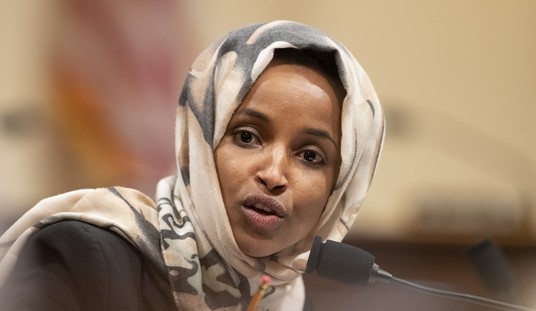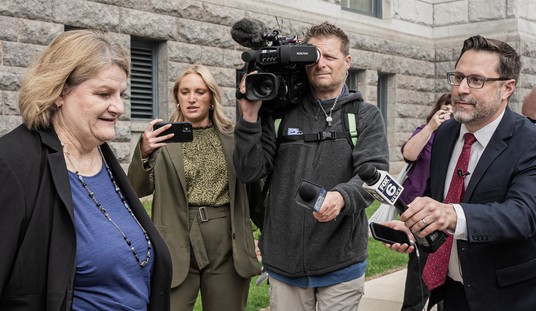Last week, the New York Times' Shane Goldmacher did a deep dive into the Democrats' bleed-out on partisan affiliation. "The stampede away from the Democratic Party is occurring in battleground states, the bluest states and the reddest states, too," Goldmacher wrote, and not just a result of the Great Realignment of interstate relocations to red states from blue. Even those staying put have shifted significantly toward Republicans, especially new voters, and even more especially male voters.
However, the Great Realignment has its own consequences, and the Gray Lady sends up even more warning flares for Democrats today. By 2032, attempts to gerrymander blue states to squeeze more seats into the hands of Democrats will get mooted by population shifts already underway and continuing. Not only will that impact control of the House of Representatives, but it will also change the way presidential elections can be won. The Electoral College may become almost impossible for Democrats by the 2032 election cycle, the NYT warns:
The year is 2032. Studying the Electoral College map, a Democratic presidential candidate can no longer plan to sweep New Hampshire, Minnesota and the “blue wall” battlegrounds of Michigan, Pennsylvania and Wisconsin and win the White House. A victory in the swing state of Nevada would not help, either.
That is the nightmare scenario many Democratic Party insiders see playing out if current U.S. population projections hold. After every decennial census, like the one coming up in 2030, congressional seats are reallocated among the states based on population shifts. Those seats in turn affect how big a prize each state is within the Electoral College — or how a candidate actually wins the presidency. ...
Across all of the possible scenarios in the nine states that would be considered battlegrounds in the 2032 election, Democrats would see about a third of their current winning Electoral College combinations disappear if population projections hold. However, when looking only at the most feasible winning combinations based on voting behaviors in the 2024 election, the outlook is far worse. Of Democrats’ 25 most plausible paths to victory in 2024, only five would remain.
Before we get too far into the weeds, the blue/red state analysis only takes one so far. Candidates matter too, as do issue sets in each election. As the pandemic proved in 2020, political fortunes can change fast based on unpredictable crises and politically charged environments. The double impact of the pandemic and the riots over the death of George Floyd likely made the difference in the presidential outcome that year, plus the impression (justified) that illegal immigration and border security were no longer the top crises facing the electorate.
Unfortunately for Democrats, their Trump Derangement Syndrome has made Trump their only focus and their only issue set. Their obstinate refusal to engage on issues, along with the knee-jerk gainsay opposition to anything Trump does, leaves them on the fringe of those issues most important now to voters. Once again, the latest results from the Harvard Harris CAPS poll not only show Trump on the right side of nearly all the issues polled, but he's on the side of broad consensus:

- Deporting criminal illegal aliens: 75/25
- DOGE-style elimination of waste and fraud: 73/27
- Closing the border and discouraging illegal crossings: 67/33
- Banning males from female sports and spaces: 66/34
- Elimination DEI in government contracts: 64/36
- Use of biological sex rather than 'gender' in gov't policy: 62/38
The numbers on these positions have only barely shifted in this longitudinal polling series all year. These numbers are not partisan splits, but rather broad consensus numbers on these issues. Democrats have not yet formed any coherent policy approaches to address their position on the fringe in every single one of them. That should be a far more pressing problem than the potential shifts in the Electoral College, because any party that keeps landing on the fringe in all of these issues won't have a chance in Hades in elections where Donald Trump no longer appears on the ballot.
With that in mind, the recipe provided by the NYT sounds even more fantastical than one would surmise from just the map:
Should the projections hold, one hope for Democrats is to do what seems, at least after the 2024 election, impossible: pivot to the South. That would mean turning states like Alabama, Mississippi, Arkansas and Louisiana — all places Mr. Trump won by more than 20 percentage points — into competitive battlegrounds, and quickly.
Ahem. Take a look at the issue set above again, and try to figure out how Democrats make inroads in places like Alabama, Mississippi, Arkansas, and Louisiana. Democrats argue that the population shift includes people who are bringing progressive policy leanings with them, but why would such people leave blue states for red states? They already live in progressive policy spaces; the only reason they'd leave in significant numbers would be to flee the results of those policies, which argues for these states becoming more aligned to the consensus positions than otherwise.
Add to that the lack of resources Democrats have to expand the map. The NYT mentions that Democrats face a fundraising gap, although they don't mention the actual numbers:
Yet months into Mr. Martin’s tenure as chair, cash remains scarce after spending billions on the 2024 defeat, a record sum roughly equivalent to the gross domestic product of a small country. Top officials have discussed whether they might need to borrow money this year to keep paying the bills. The same donors who readily contributed to the 2024 effort are reluctant to sign more checks, especially as Democrats flail politically in response to the aggressive first months of the Trump administration.
The Democratic state parties in the South, meanwhile, have seen little to no investment for decades, leaving no local donor base to draw from. Most do not have more than a single office with a skeletal staff. The Alabama Democratic Party, for example, has just five people on its payroll, according to its most recent campaign finance disclosure.
Even this understates the issue. Democrats have fallen way behind on a national level as well:
After a brutal 2024 election and several months into rebuilding efforts under new party leadership, the DNC wildly trails the Republican National Committee by nearly every fundraising metric. By the end of June, the RNC had $80 million on hand, compared to $15 million for the DNC.
And the gap — nearly twice as large as it was at this stage in Trump’s first presidency — has only grown in recent months, a POLITICO analysis of campaign finance data found, fueled by several distinct factors.
Major Democratic donors have withheld money this year amid skepticism about the party’s direction, while the small-dollar donors who have long been a source of strength are not growing nearly enough to make up the gap. And the party has quickly churned through what money it has raised in the first half of the year, including spending more than $15 million this year to pay off lingering expenses from Kamala Harris’ presidential campaign.
The DNC has less cash this summer than it did at any point in the last five years.
The crisis won't come in 2032, in other words; it will come in 2028, even before the shifts in the Electoral College take place. It may even come in 2026, ahead of a midterm cycle that Democrats would have a shot at winning if they had (a) resources and (b) a coherent agenda that addresses the consensus on the main issues for voters. It's a situation similar to the collapse of late-night television; Democrats have curated an Antifa audience, and now they're getting Antifa-level resources and support. And this doesn't even touch on the consequences for Democrats' four-year fraud on American voters to cover up Joe Biden's incapacity for office and their attempt to marionette him through a second four-year term.
Play stupid games ... win stupid prizes.








